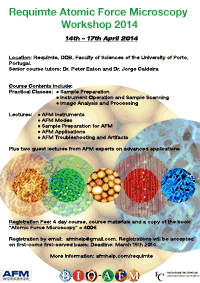I recently received some praise for my book, and I thought I'd share some reviews with you. Alexander Kraft, from Wacker Chemie AG; said the book represents " A good possibility for beginners in AFM to understand the basics and to gain a deeper insight in this measurement method." Thanks, Alexander! Here are some more quotes:
"A super-clear, easy-to-read, informative, and intuitive introduction to AFM, the best I have found. Normally, I find that books like this can be a bit dense and/or skip over details of how things work, but this book builds everything up intuitively and with such clarity it'd probably be able to be understood by a freshman college student--but, without sacrificing the necessary detail."
- Reviewer at Amazon.com
"Atomic Force Microscopy provides the basic knowledge necessary for successful AFM operation while avoiding the trap of providing more detail than beginners can handle. It boasts seven chapters, each of them accessible and self-contained; readers can thus cherry-pick the topics of relevance for their specific problems. After a short introduction about the historical background and the contemporary context, the book covers practical issues such as understanding AFM design; working in operational modes; measuring, processing, and analyzing AFM images; and spotting and avoiding artifacts. For readers inclined to explore further uses, the book's last chapter discusses various applications that illustrate the multitude of measurement options available with AFMs...Atomic Force Microscopy is a great introduction to AFMs for beginners and, although light on theory, also serves as a good starting point for more serious users."
- Udo D. Schartz, in Physics Today
"I recommend this book to any reader who wants to enter the world of force microscopy. This book is easy to read, entertaining, with a practical approach that allows, after their reading, have a realistic idea and practice of this technique. This book touches on all the points and issues that are critical to understanding the proximity microscopy.
These include instrumentation, measurement modes, familiarization with the images, the routine procedures for image processing, one section devoted to artefacts and finally potential applications of the technique. From my point of view, is one of the books on microscopy of proximity, which is easier to read and with a high applicability in measuring routines."
- Carmen Serra, Nanotechnology and Surface Analysis Service, University of Vigo
Finally, a reminder: in April 2014, We will be giving another of our successful AFM training course. At the time of writing there is ONE places left on the course. I recommend anyone interested to sign up as soon as possible. Click the image below for more information.
